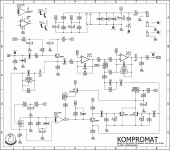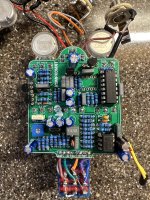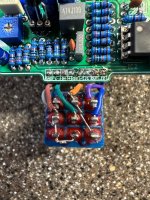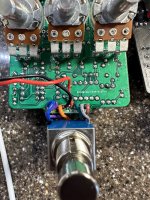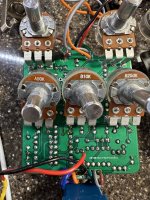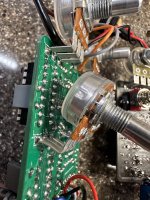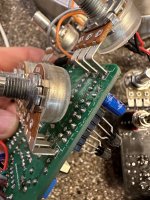mkstewartesq
Well-known member
(edit to add - sorry the numbers on the voltage table run together- it looks properly spaced when composing and even now when I went to edit, but when published they run together - so I've separated the spec from myactual by a comma)
Well, after a good run of builds where it either worked straightaway or had an issue I could quickly diagnose and fix, my streak has ended. I'm stumped on this one.
MadBean Kompromat, part of a 2-in-1 build with a General Tso. I note this because, in the pictures, you can see that it shares a power jack with another pedal (the Tso) but I keep inputs and outputs separate until Ive tested each build to verify it. The Tso works fine, and the only thing the two boards currently share is the power jack. ( If the output jack looks weird (black cable), it's because I am using a shielded cable there, with the sheath grounded to the sleeve (along with the ground wire running from the sleeve to the ground on the board. The current input isn't shielded because I will remove it when I combine the two pedals where the Tso input will be shielded.)
Since the Kompromat is a mix of the Keeley and a Barber Tone Press, I expected more compression. I see that my voltages on the IC are fairly spot on in some cases, and off in others. For at least two pins on the LM13700, I get ZERO or near-zero readings. I'll list the expected voltages along with my actual below. (note that the empty space in the board is for a CA3080 , which is not used in this build if the LM13700 is used). I'm also getting some weird phasey sound as a note decays if I turn the attack knob (top row, far right) fully counterclockwise. So something is up somewhere.
Pictures attached, Because the pots are installed, I tried to bend them back to give a view of the board joints hat would otherwise be obscured. Schematic also attached.
Any help appreciated. Thanks in advance.
Mike
Voltages MadBean Spec Mine
IC1 (CA3080) OMITTED
IC2 (TL072)
1 4.59 , 4.36
2 4.72 , 6.36
3 4.57 , 4.23
4 0 , 0
5 4.58 , 4.26
6 4.58 , 4.36
7 4.58 , 4.38
8 9.18 , 8.7
IC3 (LM13700)
1 1.2 , 1.3
2 2.11 , 0.68 (sometimes 0)
3 4.6 , 3.3
4 4.6 , 3.7
5 2.5 , 3.7
6 0 , 0
7 Ignore
8. 1.84 , ZERO (no reading at all)
9 Ignore
10 Ignore
11 9.18 , 8.71
12 Ignore
13 Ignore
14 Ignore
15 Ignore
16 Ignore
Q1 (2n3904)
C 7.64 , 7.16
B 2.06 , 1.34
E 1.54 , 1.49
Q2 (2n3904)
C 7.02 , 5.1
B 2.72 , 3.76
E 2.15 , 3.64
Q3 (2n3904)
C 8.9 , 7.38
B -mv , 0
E 0 , 0
Q4 (2n3904)
C 8.9 , 7.36
B -mv , 0
E 0 , 0
Q5 (2n3904)
C 9.18 , 8.71
B 8.9 , 7.3
E 8.47 , 7.78
Well, after a good run of builds where it either worked straightaway or had an issue I could quickly diagnose and fix, my streak has ended. I'm stumped on this one.
MadBean Kompromat, part of a 2-in-1 build with a General Tso. I note this because, in the pictures, you can see that it shares a power jack with another pedal (the Tso) but I keep inputs and outputs separate until Ive tested each build to verify it. The Tso works fine, and the only thing the two boards currently share is the power jack. ( If the output jack looks weird (black cable), it's because I am using a shielded cable there, with the sheath grounded to the sleeve (along with the ground wire running from the sleeve to the ground on the board. The current input isn't shielded because I will remove it when I combine the two pedals where the Tso input will be shielded.)
Since the Kompromat is a mix of the Keeley and a Barber Tone Press, I expected more compression. I see that my voltages on the IC are fairly spot on in some cases, and off in others. For at least two pins on the LM13700, I get ZERO or near-zero readings. I'll list the expected voltages along with my actual below. (note that the empty space in the board is for a CA3080 , which is not used in this build if the LM13700 is used). I'm also getting some weird phasey sound as a note decays if I turn the attack knob (top row, far right) fully counterclockwise. So something is up somewhere.
Pictures attached, Because the pots are installed, I tried to bend them back to give a view of the board joints hat would otherwise be obscured. Schematic also attached.
Any help appreciated. Thanks in advance.
Mike
Voltages MadBean Spec Mine
IC1 (CA3080) OMITTED
IC2 (TL072)
1 4.59 , 4.36
2 4.72 , 6.36
3 4.57 , 4.23
4 0 , 0
5 4.58 , 4.26
6 4.58 , 4.36
7 4.58 , 4.38
8 9.18 , 8.7
IC3 (LM13700)
1 1.2 , 1.3
2 2.11 , 0.68 (sometimes 0)
3 4.6 , 3.3
4 4.6 , 3.7
5 2.5 , 3.7
6 0 , 0
7 Ignore
8. 1.84 , ZERO (no reading at all)
9 Ignore
10 Ignore
11 9.18 , 8.71
12 Ignore
13 Ignore
14 Ignore
15 Ignore
16 Ignore
Q1 (2n3904)
C 7.64 , 7.16
B 2.06 , 1.34
E 1.54 , 1.49
Q2 (2n3904)
C 7.02 , 5.1
B 2.72 , 3.76
E 2.15 , 3.64
Q3 (2n3904)
C 8.9 , 7.38
B -mv , 0
E 0 , 0
Q4 (2n3904)
C 8.9 , 7.36
B -mv , 0
E 0 , 0
Q5 (2n3904)
C 9.18 , 8.71
B 8.9 , 7.3
E 8.47 , 7.78


